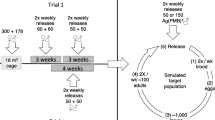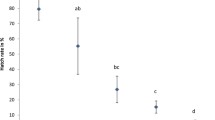Abstract
Cycling populations ofA. aegypti of wild origin were established in outdoor cages. Releases were then made for 32–43 days of either males carrying chromosome translocations or males of the sex ratio distorter type. The translocation caused a maximum of 50% sterility, but this declined rapidly after termination of releases. The distorter males depressed the proportion of females among the pupae produced in the cage to a minimum of 35% and the distortion of sex ratio persisted for 13 weeks following termination of releases. It was pos sible to simulate the effects of the releases with a computer. Simulations were also made of standard release schedules of three types of genetic material. A strain carrying both sex ratio distortion and a translocation gave the most effective population suppression.
Similar content being viewed by others
References
CURTIS, C.F. and ROBINSON, A.S. 1971. Computer simulation of the use of double translocations for pest control. Genetics,69, 97–113.
CURTIS, C.F., GROVER, K.K., SUGUNA, S. G., UPPAL, D. K., DIETZ, K., AGARWAL, H. K. and KAZMI, S. J. 1976. Comparative field cage tests of the population suppressing efficiency of three genetic control systems forAedes aegypti. Heredity,36(1), 11–29.
FAY, R. W. 1964. The biology and bionomics ofAedes aegypti in the laboratory. Mosquito News,24, 300–308.
FAY, R. W. and ELIASON, D. A. 1966. A preferred oviposition site as surveillance method forAedes aegypti. Mosquito News,26, 531–535.
HICKEY, W. A. and CRAIG, G. B. 1966. Genetic distortion of sex ratio in a mosquitoAedes aegypti. Genetics,53, 1177–1196.
HICKEY, W.A. and CRAIG, G.B. 1966b. Distortion of sex ratio in populations ofAedes aegypti. Can. J. Genet. & Cytol.,8, 260–278.
HICKEY, W.A. 1970. Factors affecting the distortion of sex ratio inAedes aegypti. J.Med.Ent.,7, 727–735.
LORIMER, N., HALLINAN, E. and RAI, K. S. 1972. Translocation homozygotes in the yellow fever mosquitoAedes aegypti. J. Hered.,63, 159-l65.
McDONALD, P. T. and RAI, K.S. 1971. Population control potential of heterozygous translocations as determined by computer simulations. Bull. Wld. Hlth.Org.,44, 829–845.
RAI, K.S., GROVER, K. K. and SUGUNA, S. G. 1973. Genetic manipulation of the mosquitoAedes aegypti 1. Use of a genetic marker and a chromosomal trans rotation in field studies. Bull. Wld. Hlth. Org.,48, 49–56.
RAI, K.S., LORIMER, N. and HALLINAN, E. 1974. The present status of genetic methods for controllingAedes aegypti. In: Whitten M. J. and Pal, R., eds, The use of genetics in insect control, North Holland, pp. 119–132.
RAI, K.S., McDONALD, P. T. and ASMAN Sr. M. 1970. Cytogenetics of two radiation induced sex linked translocations in the yellow fever mosquitoAedes aegypti. Genetics,66, 635–651.
SINGH, K.R.P., BROOKS, G. D. and ANSARI, M.A. 1974. Mass rearing of mosquitos. J. Comm. Dis.,6, 121–126.
SUGUNA, S. G. and CURTIS, C.F. 1974. Sex ratio distorter strains inAedes aegypti. J. Comm. Dis.,6, 102–105.
UPPAL, D.K., CURTIS, C.F. and RAI, K.S. 1974. A double translocation heterozygote inAedes aegypti. J. Comm. Dis.,6, 98–101.
Author information
Authors and Affiliations
Additional information
Part of the work done on production of the translocation strains at the University of Notre Dame received partial support from ERDA through Contract E(11-1)-78. This is ERDA document no. COO-38-1037.
Rights and permissions
About this article
Cite this article
Curtis, C.F., Lorimer, N., Rai, K.S. et al. Simulation of alternative genetic control systems forAedes aegypti in outdoor cages and with a computer. J Genet 62, 101–115 (1976). https://doi.org/10.1007/BF02984217
Issue Date:
DOI: https://doi.org/10.1007/BF02984217




